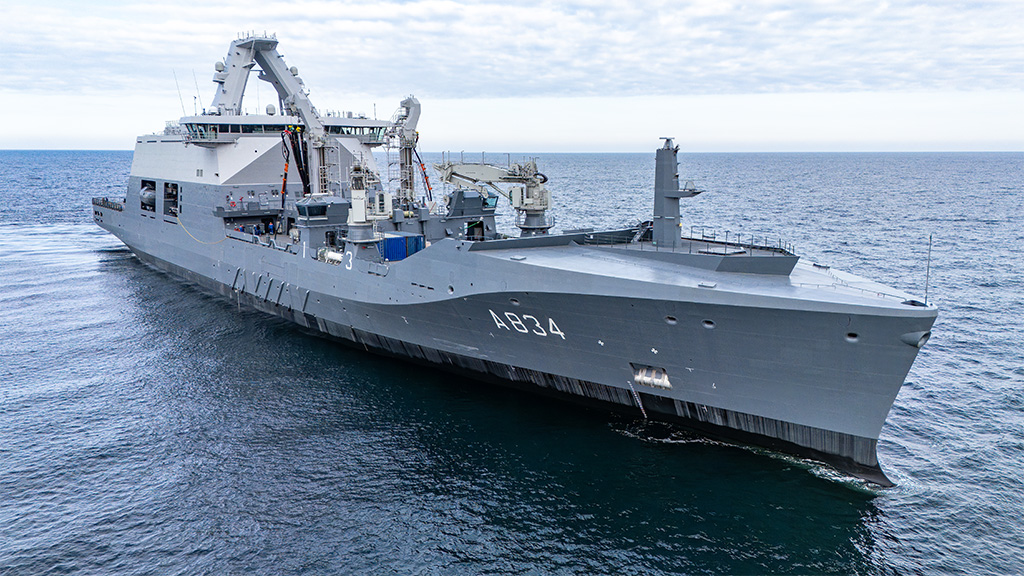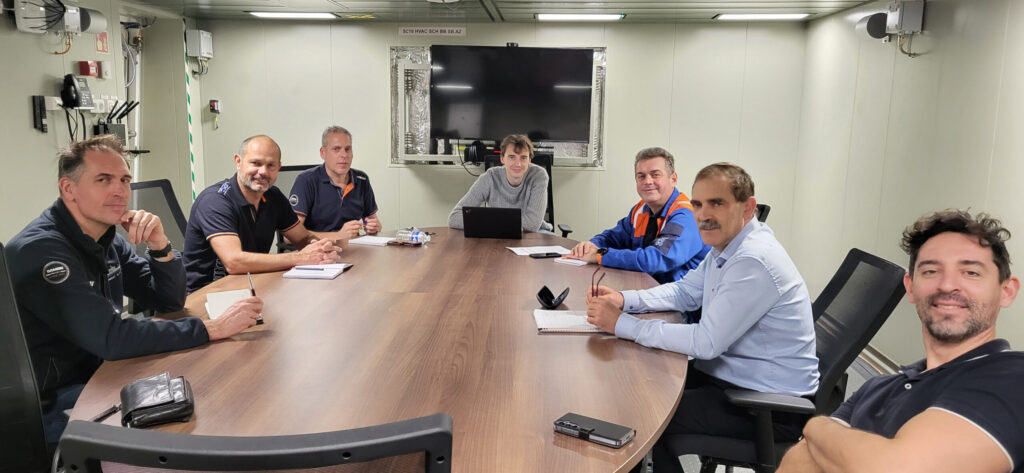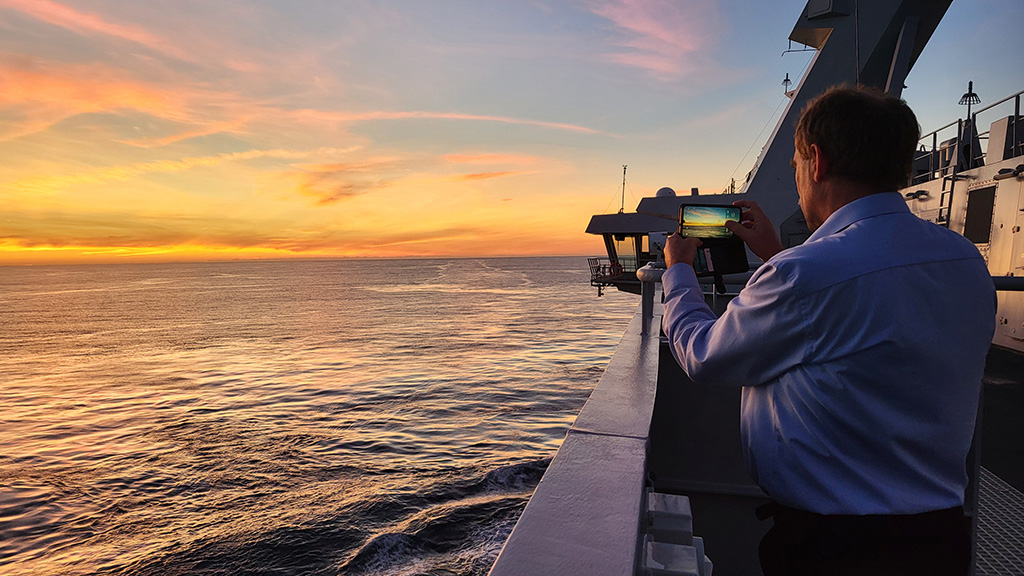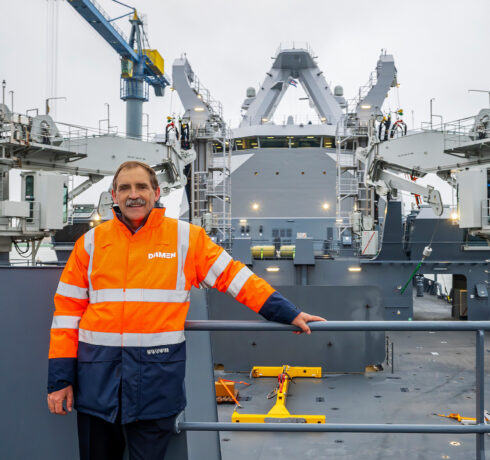In September 2020, Project Director Arjan Risseeuw made the prediction that the new Combat Support Ship would “simply be a beautiful ship”. Four years later, when CSS Den Helder entered the port of Vlissingen, he could show that that prediction has come true. For the Royal Netherlands Navy’s new supply ship is indeed a beautiful vessel and one that has successfully completed its first sea trials.
So it was a proud Arjan who watched from the bridge as the ship docked at the E Quay at Vlissingen-Oost a little after 7.30am on 13 December 2024. There was plenty of media interest on the quay and State Secretary of Defence Gijs Tuinman was also present to welcome the ship and its crew. “It is fantastic that we have arrived in Vlissingen. It is always a moment of pride when you sail along the boulevard and arrive at the shipyard,” Arjan told us.
 The Combat Support Ship Den Helder during the sea trials from Romania to the Netherlands.
The Combat Support Ship Den Helder during the sea trials from Romania to the Netherlands.
Arjan oversaw the entire sea trials and was the primary person on board responsible on behalf of Damen Naval. He was assisted by sea trials advisor and right-hand man Martin Wattel, sea trials coordinator Hannes Pauwelyn and a team of project managers, engineers and commissioning engineers. Arjan: “You always look forward to the sea trials, because that is the moment when you see everything come together and the ship has to be able to support itself independently. It’s quite a challenge to suddenly have 160 people on board and still be able to make sure everyone has their food and drink. I think it all went very well.”
Due to a combination of factors, the ship carried out sea trials more than six months later than initially planned. “Without downplaying this setback, this ultimately had an advantage. Because the CSS has been in Galaţi longer than we had thought beforehand, it is a more mature ship than other ships I have experienced on trials,” says Arjan. “The crew’s enthusiasm about the ship is undiminished and we have had no major problems. The ship held up well and the propulsion has proven to be reliable. There have been some minor issues, but overall the voyage went smoothly.”
 The first meeting of the day, at 7.15am, with from left to right: Niels Dekker, Martin Wattel, Rinko Rottier, Hannes Pauwelyn, Laurentiu Rugina, Arjan Risseeuw and Joaquin Castellano.
The first meeting of the day, at 7.15am, with from left to right: Niels Dekker, Martin Wattel, Rinko Rottier, Hannes Pauwelyn, Laurentiu Rugina, Arjan Risseeuw and Joaquin Castellano.
The CSS departed Galaţi on 16 November and sailed down the Danube to the Black Sea. There, a number of tests were conducted off the coast of Bulgaria, before the ship sailed through the Bosphorus and arrived at Souda Bay, Crete, on 21 November. From there, the journey continued to Malta, Majorca, Lisbon, Den Helder and Vlissingen.
Although the ship was underway for four weeks, there was still pressure on the schedule to perform all Sea Acceptance Tests (SATs). “Scheduling all the tests and measurements took some effort, as the schedule constantly shifted. Sometimes we had made a schedule for the day in the morning that looked completely different an hour later,” says Arjan. “Then it is a lot of work to get all parties together and create the right conditions. However, it worked out every time and we were right on schedule. The number of sea trial points is modest and these also partly consist of additional wishes from COMMIT and the crew.”
 Arjan during one of the beautiful sunsets on the Mediterranean.
Arjan during one of the beautiful sunsets on the Mediterranean.
Apart from the crew and the Damen Naval team, representatives from the Materiel & IT Command (COMMIT) and the Directorate of Materiel Sustainment (DMI) were also on board. “That means there are different parties with different interests on board,” Arjan explains. “The crew is concerned with the ship’s operations. As Damen Naval, we have to demonstrate things and COMMIT has to take those same things from us. That’s intensive, but in the end we get to where we all want to be: at a beautiful, functional naval ship. It is special to do this together.”
After the arrival, work immediately started on finalising the remaining items and carrying out the additional work. Indeed, there are still a number of important events scheduled: the christening in February, a crossing to Den Helder with some remaining SATs and the handover of the ship to COMMIT. “While we still have quite a bit of work to do, these are exciting times and I am very much looking forward to everything that is to come,” concludes Arjan.
Also read the stories of our team on board and the report by Corporate Communication Advisor Eefje Koppers.

